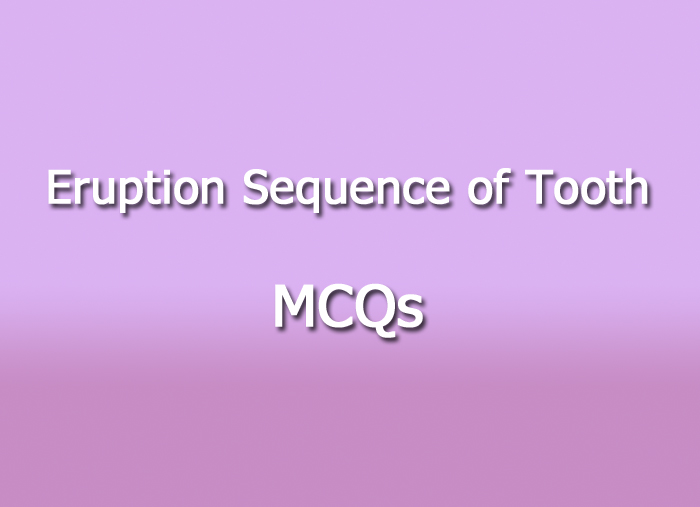- NEED HELP? CALL US NOW
- +919995411505
- [email protected]

1.The last primary tooth to be replaced by a permanent tooth Is usually the
a) Maxillary second molar
b) Mandibular second molar
c) Maxillary canine
d) Mandibular canine
2.Number of teeth seen on x-ray at birth
a) 20
b) 22
c) 24
d) 30
3.Eruption date of deciduous maxillary second molars
a) 20 months
b) 18 months
c) 24 months
d) 28 months
4.The first permanent tooth to erupt in the oral cavity is
a) Mandibular central incisors
b) Mandibular first molar
c) Maxillary central incisor
d) Maxillary first molar
5.Generally in majority of children, the sequence of eruption Of permanent teeth In mandible is
a) 1-6-2-3-5-4-7-8
b) 6-1-2-4-5-3-7-8
c) 6-1-2-3-4-5-7-8
d) 6-1-2-4-3-5-7-8
6.While charting the dentition of a child , the Pedodontist find that the following teeth are present in all the four quadrant’s, permanent central incisors, permanent lateral incisor, deciduous cuspid,Decidious first molar, deciduous second molar and permanent First molar. eruptive pattern may be considered most nearly normal for a child aged
a) 3-6 years
b) 7-10 years
c) 11-14 years
d) 15-18 years
7.What is the amount of time required by erupting premolar to move through 1MM of bone as measured on a bitewing radiograph?
a) Three to four months
b) four to five months
c) Five to six months
d) Six to seven months
8. Primary canine erupts
a) After D
b) Before B
c) After B
d) After E
9. The deciduous canine emergesa) Before lateral incisor
b) Before first molar
c) After first molar
d) After second molar
10. A 6 year old child, received tetracycline. noticeable discoloration will be seen in
a) Premolars, incisors and first molars
b) Canine and 2nd molars
c) Canine, premolars and second molars
d) Incisors and 1st molars
Answer with explanation
1. C
Permanent maxillary canines are the last teeth to erupt into oral cavity. They replace the deciduous canine and erupt into the oral cavity at the age of 11 to 12 years.
2. C
At birth all the deciduous teeth and permanent first smaller can be seen in an x-ray.
3. D
4. B
First permanent tooth to calcify is maxillary first molar and first permanent tooth to erupt is mandibular first molar. the general rule is mandibular teeth tend to precede maxillary teeth in the process of eruption both in deciduous and permanent dentition. Mixed dentition. Begins with the emergence of mandibular first molar.
5. C
6. B
As the permanent lateral incisors in all the four quadrant’s have erupted, the age should be above Eight years and as the deciduous canines, Molars are present the age should be below 10 years.
7. B
erupting premolars usually requires four to five months to move through minimum of 1 mm of bone as measured on a bite wing radiograph.
8. A
9. C
10. C
Tetracycline causes staining of teeth, which are in the process of calcification. at six years of age, first molars and incisor are calcified completely so staining does not occur in them. Canine, premolar and second molars are in the process of calcification, so they are affected bye tetracycline. Calcification of permanent teeth is completed by eight years with the exception off third molars.




